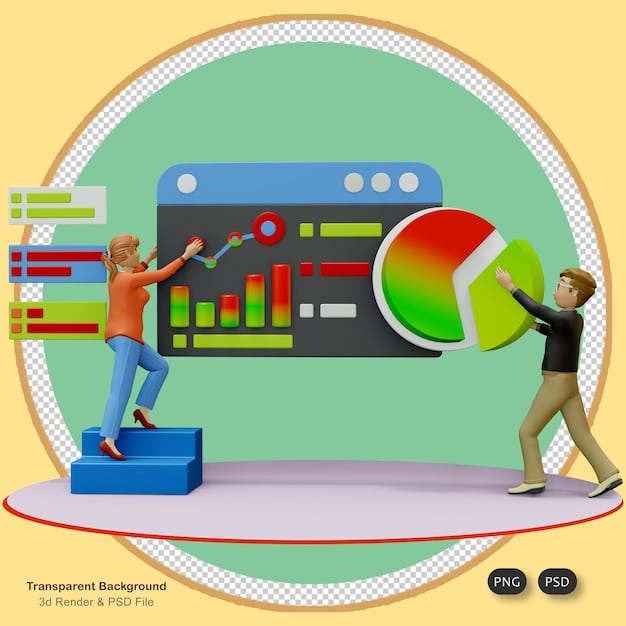Personalized Learning: Data-Driven Education in US Schools

Personalized learning paths in US schools leverage data to tailor education to individual student needs, enhancing engagement and improving outcomes through customized instruction and support.
The landscape of education in the United States is undergoing a significant transformation, driven by the power of data and the promise of personalized learning paths. Schools are increasingly adopting innovative strategies to cater to the unique needs of each student, moving away from the traditional one-size-fits-all approach.
The Rise of Personalized Learning in US Education
Personalized learning is no longer a futuristic concept; it’s a present-day reality for many schools across the US. This approach recognizes that students learn at different paces and in diverse ways, and it seeks to adapt the educational experience accordingly.
Understanding Personalized Learning
At its core, personalized learning involves:
- Identifying each student’s strengths, weaknesses, and learning preferences.
- Setting individualized learning goals based on these unique attributes.
- Providing customized instruction and resources to help students achieve their goals.
- Regularly monitoring student progress and adjusting the learning path as needed.
This student-centered approach aims to increase engagement, improve academic outcomes, and foster a lifelong love of learning.
Ultimately, personalized learning empowers students to take ownership of their education, creating a more meaningful and effective experience.

Data as the Driving Force Behind Customization
Data plays a crucial role in enabling personalized learning. By collecting and analyzing various types of data, schools can gain valuable insights into student learning patterns and tailor their approaches accordingly.
Types of Data Used in Personalized Learning
Schools utilize a wide range of data to personalize education, including:
- Academic performance data (grades, test scores, assignment completion rates).
- Learning style assessments (identifying visual, auditory, or kinesthetic learners).
- Behavioral data (attendance records, classroom participation).
- Student interests and goals (collected through surveys and interviews).
This data is then used to inform instructional decisions, create individualized learning plans, and provide targeted support to students.
Essentially, data provides the evidence needed to make informed decisions about how to best support each student’s learning journey.
Examples of Personalized Learning in Action
Across the US, schools are implementing personalized learning strategies in various innovative ways. Here are a few examples:
- **Adaptive learning platforms:** These online tools adjust the difficulty level of content based on student performance, providing a customized learning experience in subjects like math and reading.
- **Competency-based education:** Students progress through the curriculum based on mastery of skills and concepts, rather than seat time.
- **Personalized playlists:** Teachers create customized learning pathways for each student, using a variety of resources such as videos, articles, and interactive activities.
These examples demonstrate the flexibility and adaptability of personalized learning, showcasing how it can be tailored to fit the unique needs of different schools and students.
The Challenges of Implementing Personalized Learning
While the potential benefits of personalized learning are significant, implementing it effectively is not without its challenges. One major obstacle is the need for adequate resources and infrastructure.
Key Challenges:
- Insufficient funding for technology and professional development.
- Lack of teacher training in data analysis and personalized instructional strategies.
- Concerns about data privacy and security.
Addressing these challenges requires a commitment from policymakers, school leaders, and educators to invest in the necessary resources and infrastructure.
Overcoming these hurdles is essential to ensure that all students can benefit from the promise of personalized learning.

Teacher Roles in a Data-Driven Classroom
In a personalized learning environment, the role of the teacher evolves from a traditional lecturer to a facilitator of learning. Teachers become data analysts, instructional designers, and personalized learning coaches.
New Roles for Teachers
Teachers need to be proficient in:
- Analyzing student data to identify learning needs and personalize instruction.
- Creating engaging and relevant learning experiences that cater to individual student interests.
- Providing targeted support and feedback to help students achieve their goals.
This requires a shift in mindset and a commitment to continuous professional development.
Empowering teachers with the necessary skills and resources is crucial for successful implementation of personalized learning.
The Future of Personalized Learning in US Schools
The future of education in the US is increasingly intertwined with personalized learning. As technology continues to advance and our understanding of how students learn deepens, we can expect to see even more innovative approaches to personalized education emerge.
Evolving Trends in Personalized Learning
Looking ahead, we can anticipate:
- Increased use of artificial intelligence (AI) to personalize learning experiences.
- Greater emphasis on social-emotional learning (SEL) as an integral part of personalized education.
- Expanded opportunities for students to engage in project-based and inquiry-based learning.
By embracing these trends, schools can create truly transformative learning experiences that prepare students for success in the 21st century.
| Key Point | Brief Description |
|---|---|
| 🎯 Individualized Learning | Tailoring education to meet the unique needs of each student. |
| 📊 Data-Driven Decisions | Using data to inform instructional strategies and monitor student progress. |
| 👩🏫 Evolving Teacher Roles | Teachers as facilitators, data analysts, and personalized learning coaches. |
| 🚀 Future Trends | AI, social-emotional learning, and project-based learning shaping the future. |
Frequently Asked Questions
▼
Personalized learning tailors education to individual student needs, strengths, and learning styles, using data to customize instruction.
▼
Data helps educators understand student progress, identify learning gaps, and adjust teaching methods for better outcomes.
▼
Benefits include increased student engagement, improved academic performance, and a greater sense of ownership over learning.
▼
Challenges include the need for resources, teacher training, and data privacy concerns. Overcoming them ensures effective implementation.
▼
Teachers become facilitators, data analysts, and coaches, guiding students through individualized learning paths and offering support.
Conclusion
Personalized learning paths, driven by data, are transforming education in US schools, promising a more engaging, effective, and equitable learning experience for all students. While challenges remain, the potential benefits of this approach are undeniable, paving the way for a future where every student has the opportunity to reach their full potential.





